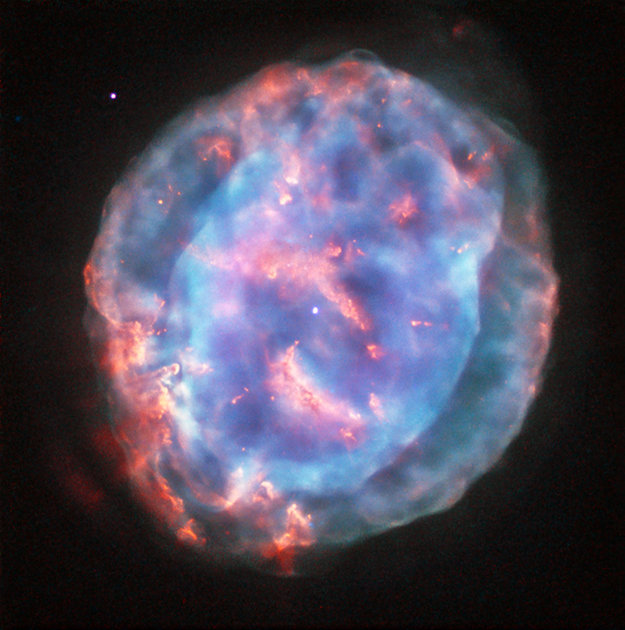La nebulosa Pequeña Gema y sus preciosos colores
7 noviembre 2016
El telescopio espacial Hubble de la NASA/ESA ya había fotografiado NGC 6818 con anterioridad, pero ha sido esta nueva mirada a la nebulosa planetaria, con una nueva mezcla de filtros de color, la que nos ha revelado su inmensa belleza. Al brillar sus asombrosos tonos turquesa y rosados en todo su esplendor, NGC 6818 hace honor a su nombre: la Pequeña Gema
Esta nube de gas se formó hace unos 3.500 años, cuando una estrella similar al Sol alcanzó el final de su vida y expulsó sus capas exteriores al espacio. A medida que las capas de material estelar escapaban del núcleo —el remanente estelar blanco que se aprecia en el centro de la imagen—, terminaron por adoptar formas caprichosas.
NGC 6818 presenta unos enrevesados filamentos rosados y dos claras capas turquesa: una interior, ovalada y brillante, y otra exterior, esférica y que envuelve a la primera como un velo traslúcido.
La estrella central cuenta con una tenue compañera a unas 150 unidades astronómicas de distancia, o cinco veces la distancia entre el Sol y Neptuno. Para verlas solo tenemos que ampliar la imagen en el centro: el punto blanco no es perfectamente esférico, sino que se aprecian dos puntos juntos.
Con un diámetro de algo más de medio año luz, la nebulosa planetaria en sí es unas 250 veces mayor que el sistema binario. En cambio, la materia de la nebulosa está lo bastante cerca de su estrella progenitora como para que la radiación ultravioleta liberada por la estrella ionice el gas polvoriento y lo haga brillar.
Los científicos creen que la estrella también expulsa partículas a alta velocidad —viento estelar— que son las responsables de la forma ovalada de la región interior de la nebulosa. Este rápido viento empuja el gas que se mueve lentamente, perforando la burbuja interior por los extremos del óvalo que vemos abajo a la izquierda y arriba a la derecha de la imagen.
NGC 6818 se encuentra en la constelación de Sagittarius (El Arquero), a unos 6.000 años luz de la Tierra. Fue fotografiada por primera vez por la Cámara Planetaria y de Gran Angular 2 del telescopio espacial Hubble en 1997. En 1998 y 2000 volvió a fotografiarse con distintos filtros de color para destacar los diversos gases de la nebulosa.
English Version :
Little Gem Nebula shows off its jewel tones

- Title Little Gem Nebula shows off its jewel tones
- Released 07/11/2016 10:25 am
- Copyright ESA/Hubble & NASA; acknowledgement: J. Schmidt (geckzilla.com)
- DescriptionThe NASA/ESA Hubble Space Telescope had imaged NGC 6818 before, but it took another look at this planetary nebula, with a new mix of colour filters, to display it in all its beauty. By showing off its stunning turquoise and rose quartz tones in this image, NGC 6818 lives up to its popular name: Little Gem Nebula.This cloud of gas formed some 3500 years ago when a star like the Sun reached the end of its life and ejected its outer layers into space. As the layers of stellar material spread out from the nucleus – the white stellar remnant at the centre of the image – they ended up acquiring unusual shapes.NGC 6818 features pinkish knotty filaments and two distinct turquoise layers: a bright, oval inner region and, draped over it like sheer fabric, a spherical outer region.The central star has a faint stellar companion 150 astronomical units away, or five times the distance between the Sun and Neptune. You can just about make this out: if you zoom in to the centre, you’ll notice the white dot in the middle is not perfectly round, but rather two dots very close together.With a diameter of just over half a light-year, the planetary nebula itself is about 250 times larger than the binary system. But the nebula material is still close enough to its parent star for the ultraviolet radiation the star releases to ionise the dusty gas and make it glow.Scientists believe the star also releases a high-speed flow of particles – a stellar wind – that is responsible for the oval shape of the inner region of the nebula. The fast wind sweeps away the slowly moving dusty gas, piercing its inner bubble at the oval ends, seen at the lower left and top right corners of the image.NGC 6818 is located in the constellation of Sagittarius and is about 6000 light-years from Earth. It was first imaged by the Hubble Space Telescope’s Wide Field Planetary Camera 2 in 1997, and again in 1998 and 2000 using different colour filters to highlight different gases in the nebula.
- Id 368186
Guillermo Gonzalo Sánchez Achutegui
ayabaca@gmail.com
ayabaca@hotmail.com
ayabaca@yahoo.com
Inscríbete en el Foro del blog y participa : A Vuelo De Un Quinde - El Foro!


No hay comentarios:
Publicar un comentario